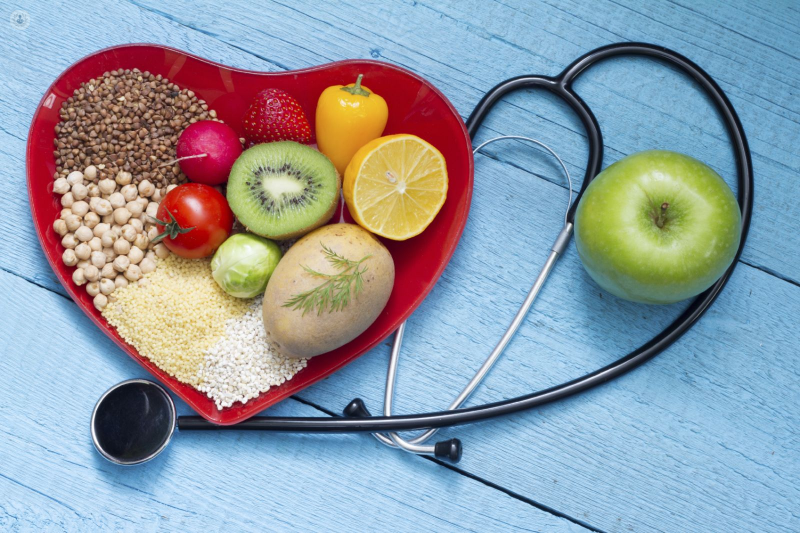The causes of high cholesterol and lifestyle measures that can lower it
Written by:Cholesterol is a type of fat that makes up the outer lining of all cells in the body and is used for making a range of hormones. It is carried in our blood to areas of the body that need it for healing, repair and growth. However, only very low levels are of cholesterol are required for our bodies to function. Unfortunately, the levels of cholesterol seen in developed societies today are much higher than they need to be and are far greater than those seen in our ancestors. Leading cardiologist Professor Kausik Ray talks about high cholesterol and what we can do to reduce our cholesterol levels.

There are two types of cholesterol; the so-called 'bad' (LDL), that builds up in blood vessels over time, causing furring (like limescale building up in a kettle), and the so-called 'good' (HDL), which carries cholesterol away from the blood vessel lining, much like descaling a kettle.
There is no such thing as 'normal' cholesterol. We are all born with bad cholesterol levels of about 0.4 millimoles per litre (mmol/L), but these levels rise over time due to environmental, lifestyle and sometimes genetic factors.
When is cholesterol dangerous?
Cholesterol is dangerous when LDL cholesterol levels are above 4.0mmol/L in children or 4.9mmol/L in adults. When cholesterol levels remain this high, blood vessels become narrower due to the build-up of cholesterol sticking to the vessel walls, blood flows more slowly and this leads to a greater risk of heart attacks, strokes and bad circulation to the legs.
What causes high cholesterol levels?
- Genetics: Sometimes there are genetic reasons as to why LDL cholesterol is above 4.9mmol/L in adults. One condition called Familial Hypercholesterolemia causes high cholesterol and occurs in 1 in 250 people, but can be more common (1 in 100 people) in some populations such as Afrikaners, Ashkenazi Jews, Lebanese and French Canadians. The reason for this is that the liver, which removes LDL cholesterol from the blood doesn’t function properly because of an inherited defective gene, carried down from a parent. It’s a bit like having fishing rods catching particles (cholesterol), but only half the fishing rods are available. Children, siblings and parents of those affected by this condition have a 1:2 chance of carrying the same abnormal gene - therefore have the same risk of high LDL cholesterol - and should be tested.
- Combination of genes: For a large portion of the population, high levels of LDL cholesterol are not due to a gene abnormality, but to a combination of genes inherited from previous generations, which have increased their cholesterol levels; a single piece of a jigsaw doesn't give you the whole picture, but 1,000 pieces do.
- Other medical conditions: Those with diabetes and obesity tend to have higher levels of “bad” cholesterol and also more triglycerides than those without these conditions. Triglycerides increase chances of abdominal pain and pancreatitis, in which digestive enzymes attack the pancreas and it becomes inflamed.
- Bad diet: For the majority of the population, eating foods that are high in sugar, refined carbohydrates, fast food and saturated fats, and cooking with too much processed oil is the main cause of high LDL cholesterol.
What lifestyle measures can be adopted to reduce cholesterol?
In general (and where there are no genetic factors) a diet low in saturated fats and higher in fruit and vegetables can improve LDL cholesterol levels. For those who have high cholesterol due to genetics, lifestyle changes alone will not significantly improve bad cholesterol levels, in which case, medication will be required.
In people with high triglycerides, lifestyle changes such as reducing carbohydrate intake and alcohol consumption can make a significant change to LDL cholesterol levels. Amongst people with raised LDL cholesterol levels, it is important to address overall heart health by reducing factors which can lead to the development of other diseases, including quitting smoking, increasing exercise, and controlling high blood pressure.
How are statins used in the treatment of cholesterol?
Statins are a medicine originally derived from a type of fungus which blocks a cholesterol-producing enzyme in the liver. This results in the liver producing more cholesterol receptors, much like having more fishing rods actively collecting cholesterol particles in the blood, therefore LDL cholesterol levels are lowered. Statins reduce the risk of heart disease and strokes by about 22% for every 1mmol/L that cholesterol is lowered and because they are safe, effective and well-tolerated, they are the current standard of care around the world.
If you would like to discuss your cholesterol levels and find out ways to manage them, make an appointment with a specialist.



